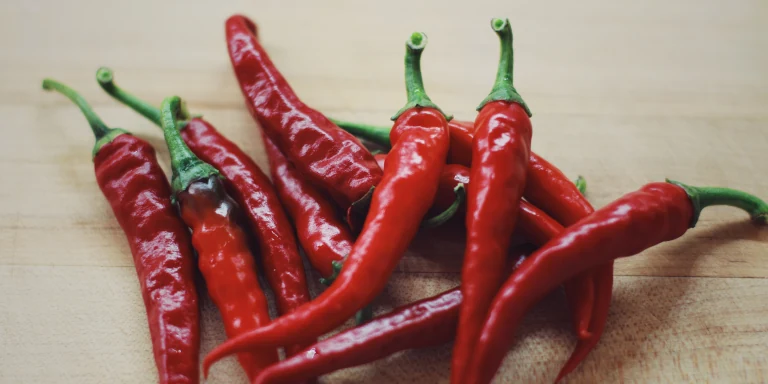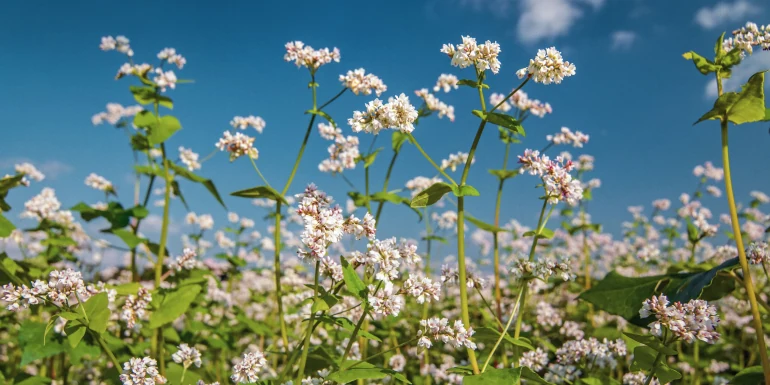
A fiery energy booster with a zing: chilli
Chilli, in the proper amount, alleviates pain, eases neck and back tension, and aids digestion. This spicy plant balances out blood sugar levels, reduces cravings for sweets and awakens a zest for life.
Chilli plants were grown and harvested in Central America as long as 7,000 years ago. Chilli farmers sought greater yields and more heat. The species frutescens, which is used in pharmaceutical applications, has a heat index of 30,000 to 50,000 SHUs (Scoville Heat Units). Habanero peppers are even hotter, easily reaching a score of 100,000 to 350,000 SHUs.
Once you get past this pain, you'll feel a euphoric sensation. This is because given too much capsaicin, the spicy substance in chillies, the brain will perceive it as an intense pain and fight it by releasing endorphins. Endorphins are chemicals that produce a feeling of happiness. Experts like to call this a «pepper high». But be careful! The only way to avoid burning your mouth the way some neophytes do when they consume habaneros without the proper respect is to go slowly.
Milk, not water
Ground chilli is used to make cayenne pepper. The main active ingredient in cayenne pepper are alkaloids called capsaicinoids. The most important capsaicinoid is capsaicin. Capsaicin is mainly found in the wall of the pepper and not, as is generally thought, in the seeds. Capsaicinoids do not break down when cooked or frozen. They are soluble in alcohol and fat, but not in water. So water won't help cool the burning sensation in your mouth. It is more effective to drink milk or a yoghurt drink, which contain emulsifiers. If your skin burns after coming into contact with a chilli, you can rub the affected area with alcohol or wash it with soap.
Cayenne pepper as a pain reliever
In therapeutic doses, cayenne pepper stimulates local pain and heat receptors, causing a sensation of warmth or even burning. This interrupts the transmission of pain by the body. In the proper dose, salves or plasters that contain capsaicin have a strong analgesic effect and promote blood circulation. Too much capsaicin can, however, cause itching, skin redness or even the formation of blisters. Applied externally, cayenne pepper counteracts muscle tension, circulatory disorders in the extremities and rheumatic pain. Taken internally as a tincture, capsicum bolsters circulation and improves the metabolism of sugar and fat. Psychologically, it increases one's energy level.
The word "chilli" comes from Nahuatl, a language spoken by some Aztec natives in Mexico. The European origin of the genus name capsicum is the Greek root word "kapsa", which was borrowed into Latin as "capsicus" (meaning spherical). The word "chilli" is now the generic term for all types of capsicums. Of the 30 known varieties of chillies, only two are used in the pharmaceutical industry: "frutescens" (shrubby) and "annum" (annual). The chillies in European supermarkets are mostly Capsicum annum varieties. Pharmaceutical preparations containing cayenne pepper, by contrast, mainly use Capsicum frutescens.
Family
Nightshade (Solanaceae)
Appearance
Depending on the variety, capsicum plants are 20 to 120 cm tall. In Europe, they bloom from June to September. In contrast to sweet peppers, the small white blossoms first develop small berries, from which the pointed cone-shaped peppers later form. The colours range from yellow to orange and red to brown. Today's crops are now a feast for the eyes, spanning the entire colour spectrum.
Location
Originally cultivated in Mexico, then throughout Central America and now grown in greenhouses.
Botanical classification
Botanically, capsicum plants are annual or perennial herbs, shrubs or half-shrubs.
Harvest time
The ripe fruit is picked by hand and either air dried in the shade or dried in ovens or drying machines at a maximum temperature of 35° in order to avoid loss on drying to the source of the heat, the capsaicin.
Use
As a spice: dried fruits, cut or powdered
As a medicine: salve, plaster or tincture (Capsicum annum).



Newsletter
Find out more about current health issues every month and get all the information you need about our attractive offers from all Helsana Group companies * delivered by e-mail to read whenever it suits you. Our newsletter is free of charge and you can sign up here:
We did not receive your information. Please try again later.
* The Helsana Group comprises Helsana Insurance Company Ltd, Helsana Supplementary Insurances Ltd and Helsana Accidents Ltd.